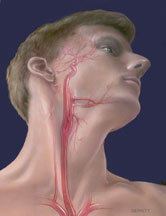Problems with the Plumbing (Circulatory) System
|
|
| When the blood vessels that circulate the body's blood supply are diseased or damaged, it may lead to abnormal heart rhythms and other types of heart problems. |
|
|
Coronary Artery Disease (CAD) affects the arteries that supply blood to the heart. If the blood supply is reduced, it may damage heart muscle and leave a scar.
This can result in irregular heartbeats (arrhythmias), including ventricular fibrillation, the major cause of sudden cardiac death.
The most common cause of artery disease is atherosclerosis (sometimes called "
hardening of the arteries"), a build-up of fatty substances called plaques on the inner walls of blood vessels.
|
| In atherosclerosis, the blood vessels become clogged with a substance called plaque. |
|
|
|
|
|
|
| Angina refers to chest pain that occurs when the heart does not get enough oxygen. It is a common symptom of coronary artery disease. People with CAD may have frequent chest pain, especially during strenuous exercise. The pain often goes away with rest. |
|
|
|
|
|
| Your blood pressure should be checked annually if it is normal or every few months if you have hypertension. |
|
High Blood Pressure (hypertension) also affects the blood vessels. When the pressure against the walls of the blood vessels is too high it can weaken artery walls and make blood vessels less flexible. This forces the heart to pump harder. The pressure may even cause blood vessels to burst, resulting in a hemorrhage (excessive bleeding) that can be fatal.
High blood pressure rarely has symptoms in its early stage. The first "sign" of hypertension may be a heart attack, stroke or kidney problem. High blood pressure is the most common cause of heart failure.
Heart attack, or myocardial infarction occurs when the blood supply to the heart is reduced or blocked, usually due to coronary artery disease. An area of dead heart muscle caused by a heart attack is called an "infarct." People who have had a heart attack are at increased risk for heart rhythm disorders, including ventricular fibrillation (VF), the major cause of sudden cardiac death. |
|
|
|
|
|
|
Stroke occurs when the blood supply to the brain is reduced or blocked. A stroke can cause permanent disability or death. The effects often can be reversed, however, if victims receive emergency treatment in the hours immediately following a stroke.
People with atrial fibrillation and atrial flutter are at increased risk of stroke.
Peripheral Vascular Disease (PVD) refers to a range of disorders that affect the blood vessels in the legs, feet, arms or hands. Blood clots that form in the blood vessels, atherosclerosis ("hardening of the arteries") and varicose veins are varieties of PVD.
| Although PVD is not heart disease, it is often the first sign of blood vessel problems that may lead to coronary artery disease. The most common symptom of PVD is pain in the feet, legs or buttocks that first is noticed during walking or other exercise. The pain almost always goes away when the person rests. |
|
|
When a blood clot lodges in the carotid arteries that supply blood to the brain, the result is stroke.




